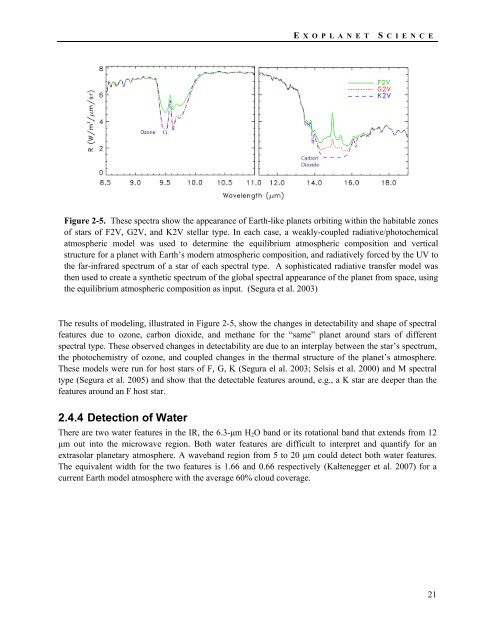TPF-I SWG Report - Exoplanet Exploration Program - NASA
TPF-I SWG Report - Exoplanet Exploration Program - NASA
TPF-I SWG Report - Exoplanet Exploration Program - NASA
You also want an ePaper? Increase the reach of your titles
YUMPU automatically turns print PDFs into web optimized ePapers that Google loves.
E X O P L A N E T S CIENCE<br />
Figure 2-5. These spectra show the appearance of Earth-like planets orbiting within the habitable zones<br />
of stars of F2V, G2V, and K2V stellar type. In each case, a weakly-coupled radiative/photochemical<br />
atmospheric model was used to determine the equilibrium atmospheric composition and vertical<br />
structure for a planet with Earth’s modern atmospheric composition, and radiatively forced by the UV to<br />
the far-infrared spectrum of a star of each spectral type. A sophisticated radiative transfer model was<br />
then used to create a synthetic spectrum of the global spectral appearance of the planet from space, using<br />
the equilibrium atmospheric composition as input. (Segura et al. 2003)<br />
The results of modeling, illustrated in Figure 2-5, show the changes in detectability and shape of spectral<br />
features due to ozone, carbon dioxide, and methane for the “same” planet around stars of different<br />
spectral type. These observed changes in detectability are due to an interplay between the star’s spectrum,<br />
the photochemistry of ozone, and coupled changes in the thermal structure of the planet’s atmosphere.<br />
These models were run for host stars of F, G, K (Segura el al. 2003; Selsis et al. 2000) and M spectral<br />
type (Segura et al. 2005) and show that the detectable features around, e.g., a K star are deeper than the<br />
features around an F host star.<br />
2.4.4 Detection of Water<br />
There are two water features in the IR, the 6.3-μm H 2 O band or its rotational band that extends from 12<br />
μm out into the microwave region. Both water features are difficult to interpret and quantify for an<br />
extrasolar planetary atmosphere. A waveband region from 5 to 20 µm could detect both water features.<br />
The equivalent width for the two features is 1.66 and 0.66 respectively (Kaltenegger et al. 2007) for a<br />
current Earth model atmosphere with the average 60% cloud coverage.<br />
21
















